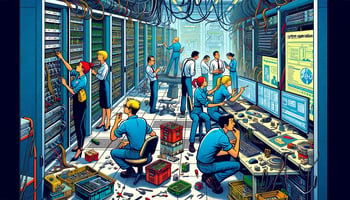AI is rapidly transforming Configure, Price, Quote (CPQ) software, but the challenge isn’t just...
The AI Adoption Curve in CPQ: From Hype to Reality
The first time you use AI to generate configuration logic, it feels like magic. You paste in a spec sheet, ask for a set of rules, and seconds later you’re looking at a structured output that would have taken hours to build by hand. You imagine what this could mean: faster implementations, fewer manual errors, and a smarter way to manage complexity.
Then you use it again. And again. Suddenly that excitement starts to fade. The assistant keeps making the same assumptions. It invents rules that no one asked for. It misses edge cases that matter. You spend more time reviewing and correcting than you would have spent just writing the logic yourself. The magic trick wears off, and you hit the low point of the curve: disappointment.
This is the AI adoption curve in CPQ. At first, you are impressed. Then you get frustrated. But if you push through, if you step back and put the right structure around how you use AI, you reach the third phase: real, sustainable value. AI stops being a novelty and becomes a disciplined tool in your modeling workflow. But only if you learn how to work with it, not just expect it to replace your expertise.
Why the Dip Happens and Why It’s a Good Sign
That second phase, the frustration phase, isn’t a failure. It is necessary. It is when you realize that AI isn’t a finished product. It is a helper that needs constraints, context, and clear expectations. This is especially true in CPQ, where product logic is tied to real-world rules, safety constraints, and complex dependencies.
The assistant does what it is told, not necessarily what you meant. It reflects the structure or lack of structure in your input documents. It doesn’t know that torque limits shouldn’t change based on a marketing flyer from 2017. It doesn't catch that two parameters are really the same thing, just named differently in different sheets.
Once you see these issues clearly, you are ready for the next phase: shaping the assistant into a productive tool instead of letting it create problems you then have to fix.
Moving to Phase Three: Structured Use of AI in CPQ
Getting to the value phase means changing how you use AI for logic generation. Here is what we have learned works best:
-
Treat output as a draft, not a result
Do not expect the assistant to generate a ready-to-deploy rule set. Expect a draft that gets reviewed, commented, and revised just like code. -
Require provenance
Every rule must include a reference to the source that inspired it. That might be a row number, a file name, or a text snippet. No source means no acceptance. -
Use test suites for validation
Build a suite of known good and bad configurations. Run them against every proposed change. If the AI-generated logic breaks something, it does not go in. -
Define a locked schema
Before you generate logic, define parameter names, units, valid ranges, and types. Enforce these rules automatically. Let the assistant generate within your framework, not outside it. -
Block certain logic from being inferred
Some things such as safety constraints, legal rules, and pricing exceptions must always be authored by people. Maintain a "do not infer" list that is enforced by your tooling.
Where AI Fits in CPQ Workflows Today
After the dip, you find the balance. AI is not here to replace your team. It is here to reduce the grunt work, to help structure messy data, to propose first drafts, and to highlight inconsistencies. Used right, it speeds up the boring parts of model building so your experts can focus on the hard problems.
We have worked with CPQ teams that now use AI to generate first-pass logic from specs and then immediately route that logic into a structured review process. They cut modeling time by 30 percent not because AI took over but because it gave them a better starting point. That is what value looks like after the hype wears off.
The Lesson of the Curve
The AI adoption curve is not a bug. It is a roadmap. The initial excitement gets you started. The frustration phase forces you to think critically. And if you stay with it, you build a system where AI works the way it should: in the background, supporting your team, not disrupting it.
Want to explore how to structure AI-assisted logic generation for your CPQ implementation? Start here: Integrating AI into CPQ: Strategic Recommendations
Ready to plan your AI journey in CPQ? Book a virtual coffee with Magnus or Patrik at cpq.se/meetcpqse




